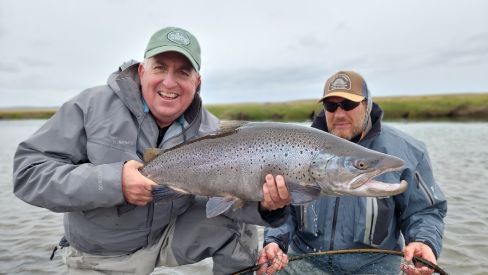Just when spring is well along the way to the onset of summer, the retamas line the roadways with their bright yellow flowers bringing with them reminiscences of their European origins. They were brought to Patagonia by the early settlers from Eastern Europe along with trout, red stags and wild boars, and quickly took to the welcoming richness of the low Andean hills. Rich green tones of abundance mark the riparian vegetation along the river courses and the evergreens dot the hillsides in groves that contrast deeply with the basalt and granite rock outcroppings. Tall poplars, swaying in the warming breezes of late spring, mark the boundaries of fields, acting as wind barriers for livestock and the few estancias on the valleys. This is a fine time in northern Patagonia!
The rivers begin to shed the tumultuous rush of the spring freshets and snow melt, and return to more stable levels along their course. The valley of the Malleo is alive with color from the many plants and trees welcoming the warmth of the season. Beautiful lupines bloom profusely in the shady riverside under the willows as trout dimple the surface of the smooth pools in anticipation of the full hatches of summer.
For a few short weeks around the middle of November, the hillsides come alive in celebration of the approaching summer with the crimson brushstrokes of the flowering notros. The landscape of the lower cordillera with its dark green hues of tall coihues, scrub brush and ancient monkey puzzle trees is highlighted by the bright scarlet accent of the notros as if a child took liberties with a bright red lipstick on the canvas of the master when he was not looking. Nature regales the visitor with a visual treat of color and contrast under increasingly clear bright skies. In the shady coves of the riverside, pungent and bright orange Llao-Llao mushrooms crowd around the trunks of ñires and lengas covering large wooden knots with a short lived exuberance.
The time of the notros is also the time of the Huaca Mamuil.
The Huaca is a small tributary of the upper Malleo on its north side and is different from most other Patagonian rivers in that it is not born as the overflow of a lake but is a true spring creek originating from natural springs seeping out of the thickly wooded mountainsides of the cordillera in the heart of Lanín National Park. This is wild, pristine and beautiful country where the mountain lion or puma still roams and wild boars abound. Andean condors soar up the wind currents and the majestic red stag rule the upper ridges, coming down into de valley to feed at dusk. Thick timber of ancient lengas, coihues and raulís cover the hills and bamboo like colihues create nearly impenetrable thickets that protect the headwaters of the Huaca, said to be connected by permeable rock to nearby Lake Tromen and the Huaca Mamuil Lagoon, host to legendary populations of large brook trout.
As a true spring creek, its waters are cold, bright and pure. And big trout ascend its course to the headwaters for spawning. Spring spawners like rainbows and brook trout seek the upper reaches of the Huaca Mamuil to build their redds in the early spring. Big brawny browns follow them to feed on the eggs or young fry and on the plentiful insect life.
Like many spring creeks, the Huaca is not a big river. About the width of a country road, it is heaven for the dry fly fisherman as all of its waters are easily within casting range. It runs along fascinating temperate forests and glades. Wild pigs make havoc with the damp grasses along the bends of the river, rutting the earth looking for tubers and roots. Red foxes peek shyly from among the flowering notros. Groves of ancient monkey puzzle trees guard the river between open spaces of closely cropped grass kept trim by the red stags and guanacos that feed mostly at dusk or dawn. There are beautiful protected spots closely resembling carefully tended Japanese gardens. You can cast or just sit in the deep shade to enjoy the beauty and solitude of this remote wild place.
But…. and it’s a big BUT…. the Huaca is different from other spring creeks in the nature of its insect life. This is not a spring creek like the Letort or many other famous US creeks in which you are required to fish tiny flies imitating minutiae insects and nymphs. Carrying only enough water for sustaining fish in the spring and early summer, the Huaca does not have significant hatches. It’s the terrestrials that the trout come seeking. You can forget 7X tippets and #22 flies! The combinations of small waters and big insects make it a unique experience for the trout angler. Large beetles, grasshoppers, tarantulas, Madame Xs and Chernobyl ants, easily fished on a 4X tippet are the ticket to success in its deceivingly deep waters. Big trout smack them with gusto from the most unsuspecting lies.
The Huaca Mamuil carries enough water for fishing from spring to mid-summer (middle of January) so you have to book early in the season to enjoy it.
It’s about time the small Huaca Mamuil is recognized and appreciated for its own merits and not just as a small tributary of the famous Malleo. I personally plan and hope to enjoy it again and again in the time of the notros.
Rafael Morillo
Sept. 2011






